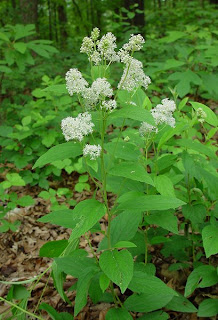AGRIMONY

Latin Name: Agrimonia eupatoria
Alternate Names: Church Steeples, Sticklewort
Family: ROSACEAE
Parts Used: Above ground portion, root.
Properties: Analgesic, Anti-inflammatory, Antispasmodic, Antiviral, Astringent, Deobstruent, Diuretic, Emmenagogue, Febrifuge, Hemostatic, Hepatic, Vulnerary.
Internal Uses: Asthma, Bladder Irritation, Bladder Stones, Bronchitis, Cancer, Cystitis, Diarrhea, Dysmenorrhea, Fever, Incontinence, Kidney Stones, Poor Digestion, Sore Throat
Internal Applications: Tea, Tincture, Capsules.
It makes an apricot scented tea. In Chinese medicine it is used to stop excessive menstrual flow. Agrimony helps to clear heat and dry dampness. When used internally or externally, it increases the level of trombocytes, thus improving coagulation.
Topical Uses: Bruises, Diarrhea, Eye Problems, Hemorrhoids, Hives, Muscle Soreness, Sprains
Topical Applications: Use as a wash for bruises, sore muscles, sprains, hives and eye ailments. Gargle for sore throat. Use as a suppository for diarrhea and hemorrhoids. When Agrimony is used as a wash for wounds it can increase blood coagulation.
Energetics: Bitter, Warm.
Chemical Constituents: Polysaccharides, tannins, flavonoids, coumarins, silica, malic acid, phytosterols, vitamins B and K, iron.
Contraindications: Use in moderation. Not for use during pregnancy or when one is constipated. High doses may slow heartbeat.
Comments: The name Agrimony has its origins in both the Greek and Anglo-Saxon term argemon, meaning speck in the eye, as this herb was used as a wash for eye problems. The species name, eupatoria, refers to an ancient Persian King, Mithrades Eupator, a renowned herbalist. Agrimony was a popular European medicine in treating wounds and was part of a formula called Eau de Arquesbusade, from a fifteenth century term for musket, arquebus. Agrimony also has been used as a yellow dye.
As a Bach Flower Remedy, it is used for people who are inwardly tortured, yet hide it from others. Its energetic is slightly bitter. Its flower essence is for those who hide their troubles with a happy face and avoid all argument.
The common name Agrimony includes the species Agrimonia pilos, Agrimonia gryposepala, and Agrimonia striata, which are used interchangeably with Agrimonia eupatoria.
Alternate Names: Church Steeples, Sticklewort
Family: ROSACEAE
Parts Used: Above ground portion, root.
Properties: Analgesic, Anti-inflammatory, Antispasmodic, Antiviral, Astringent, Deobstruent, Diuretic, Emmenagogue, Febrifuge, Hemostatic, Hepatic, Vulnerary.
Internal Uses: Asthma, Bladder Irritation, Bladder Stones, Bronchitis, Cancer, Cystitis, Diarrhea, Dysmenorrhea, Fever, Incontinence, Kidney Stones, Poor Digestion, Sore Throat
Internal Applications: Tea, Tincture, Capsules.
It makes an apricot scented tea. In Chinese medicine it is used to stop excessive menstrual flow. Agrimony helps to clear heat and dry dampness. When used internally or externally, it increases the level of trombocytes, thus improving coagulation.
Topical Uses: Bruises, Diarrhea, Eye Problems, Hemorrhoids, Hives, Muscle Soreness, Sprains
Topical Applications: Use as a wash for bruises, sore muscles, sprains, hives and eye ailments. Gargle for sore throat. Use as a suppository for diarrhea and hemorrhoids. When Agrimony is used as a wash for wounds it can increase blood coagulation.
Energetics: Bitter, Warm.
Chemical Constituents: Polysaccharides, tannins, flavonoids, coumarins, silica, malic acid, phytosterols, vitamins B and K, iron.
Contraindications: Use in moderation. Not for use during pregnancy or when one is constipated. High doses may slow heartbeat.
Comments: The name Agrimony has its origins in both the Greek and Anglo-Saxon term argemon, meaning speck in the eye, as this herb was used as a wash for eye problems. The species name, eupatoria, refers to an ancient Persian King, Mithrades Eupator, a renowned herbalist. Agrimony was a popular European medicine in treating wounds and was part of a formula called Eau de Arquesbusade, from a fifteenth century term for musket, arquebus. Agrimony also has been used as a yellow dye.
As a Bach Flower Remedy, it is used for people who are inwardly tortured, yet hide it from others. Its energetic is slightly bitter. Its flower essence is for those who hide their troubles with a happy face and avoid all argument.
The common name Agrimony includes the species Agrimonia pilos, Agrimonia gryposepala, and Agrimonia striata, which are used interchangeably with Agrimonia eupatoria.

